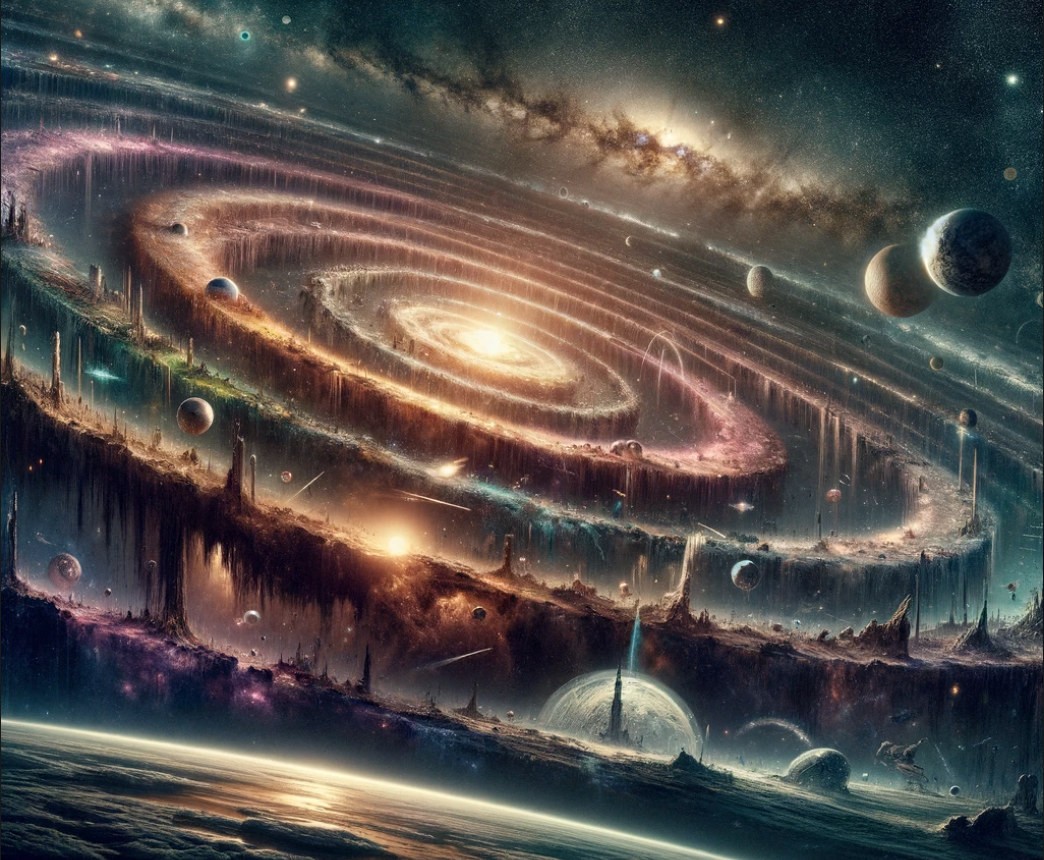A thousand trillion years, or 1 quadrillion years (1,000,000,000,000,000 years), is a time scale that far exceeds any processes we observe in the current universe. At this unimaginable scale, we enter into the realm of theoretical cosmology, dealing with scenarios far beyond the current age of the universe (which is about 13.8 billion years). Here's what such a distant future might hold, based on current scientific understanding:
一千万亿年,或一千万亿年(1,000,000,000,000,000年)是一个远远超过我们在当前宇宙中观察到的任何过程的时间尺度。 在这个难以想象的规模上,我们进入了理论宇宙学领域,处理远远超出当前宇宙年龄(约 138 亿年)的场景。 根据目前的科学理解,如此遥远的未来可能会发生以下情况:

The image conceptualizing the passage of a 'thousand trillion years' in a cosmic context has been created. It depicts a vast and expansive view of the universe, highlighting the enormity of such a time scale through elements like aging galaxies, fading starlight, and remnants of celestial bodies. The composition evokes a feeling of profound timelessness and the inexorable passage of time in the cosmos, blending both beauty and the solemnity of an ancient universe.概念化宇宙背景下“一千万亿年”的流逝的图像已经创建。 它描绘了广阔无垠的宇宙图景,通过衰老的星系、褪色的星光和天体遗迹等元素突出了这种时间尺度的巨大性。 该作品唤起了一种深刻的永恒感和宇宙中时间无情流逝的感觉,融合了古老宇宙的美丽和庄严。
质子衰变(如果发生):如果质子不稳定,它们可能会在如此大小的时间尺度上衰变。 假设质子的半衰期至少为 10^34 年,因此在 1000 亿年里,普通物质中的许多质子可能会衰变,从根本上改变宇宙中剩余物质的构成。
黑洞时代:到这个时候,大多数恒星遗迹都会消失。 宇宙将由各种大小的黑洞主宰。 这些黑洞本身会通过霍金辐射慢慢蒸发,对于最大的超大质量黑洞来说,这个过程可能需要长达 10^100 年的时间。 然而,较小的黑洞会更早蒸发。
黑暗时代:黑洞时代之后,随着黑洞蒸发,宇宙进入所谓的黑暗时代。 在此期间,剩下的将是极低能量的光子、电子、正电子和中微子,在广阔、寒冷和黑暗的宇宙中漂流。
可能的新物理和未知事件:在如此长的时间尺度上,不能排除全新物理过程或未知事件的可能性。 宇宙的行为可能会受到目前未知或未知的因素或物理定律的影响。
宇宙的命运:宇宙的最终命运,是否会无限期地继续膨胀,导致大冰冻,在大挤压中塌陷,经历大撕裂,还是经历一些其他未知的命运,仍然是一个科学话题。 研究和辩论。
值得注意的是,这些预测是基于当前科学理解的推断,本质上是推测性的。 随着我们对宇宙的了解不断发展,我们对其遥远未来的预测也会不断发展。
Proton Decay (If It Occurs): If protons are unstable, they might decay over time scales of this magnitude. The half-life of a proton is hypothesized to be at least 10^34 years, so in a quadrillion years, many protons in ordinary matter could have decayed, fundamentally altering the makeup of the remaining matter in the universe.
Black Hole Era: By this time, most stellar remnants would have faded away. The universe would be dominated by black holes of various sizes. These black holes themselves will slowly evaporate through Hawking radiation, a process that could take up to 10^100 years for the largest supermassive black holes. However, smaller black holes would have evaporated much earlier.
Dark Era: Following the Black Hole Era, as black holes evaporate, the universe enters what is known as the Dark Era. During this period, all that remains would be extremely low-energy photons, electrons, positrons, and neutrinos, drifting through a vast, cold, and dark universe.
Possible New Physics and Unknown Events: On such long time scales, the potential for entirely new physical processes or unknown events cannot be ruled out. The behavior of the universe could be influenced by factors or laws of physics that are not currently understood or known.
The Fate of the Universe: The ultimate fate of the universe, whether it will continue expanding indefinitely leading to a Big Freeze, collapse back in a Big Crunch, experience a Big Rip, or undergo some other unknown fate, is still a topic of scientific research and debate.
It's important to note that these predictions are based on extrapolations of current scientific understanding and are inherently speculative. As our knowledge of the universe evolves, so too might our predictions for its distant future.
